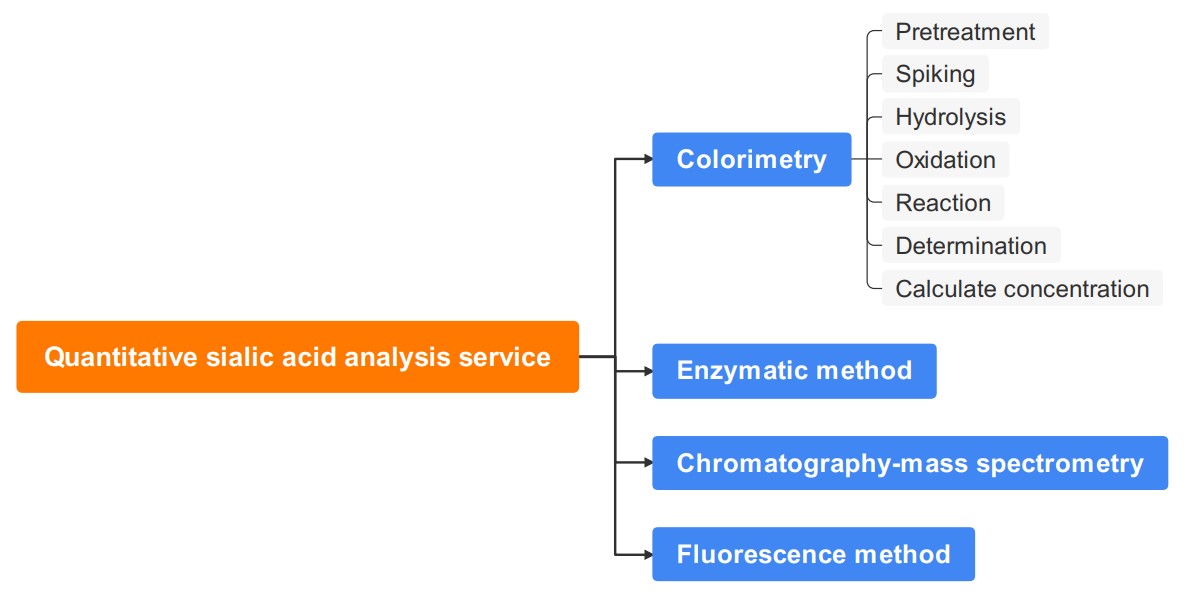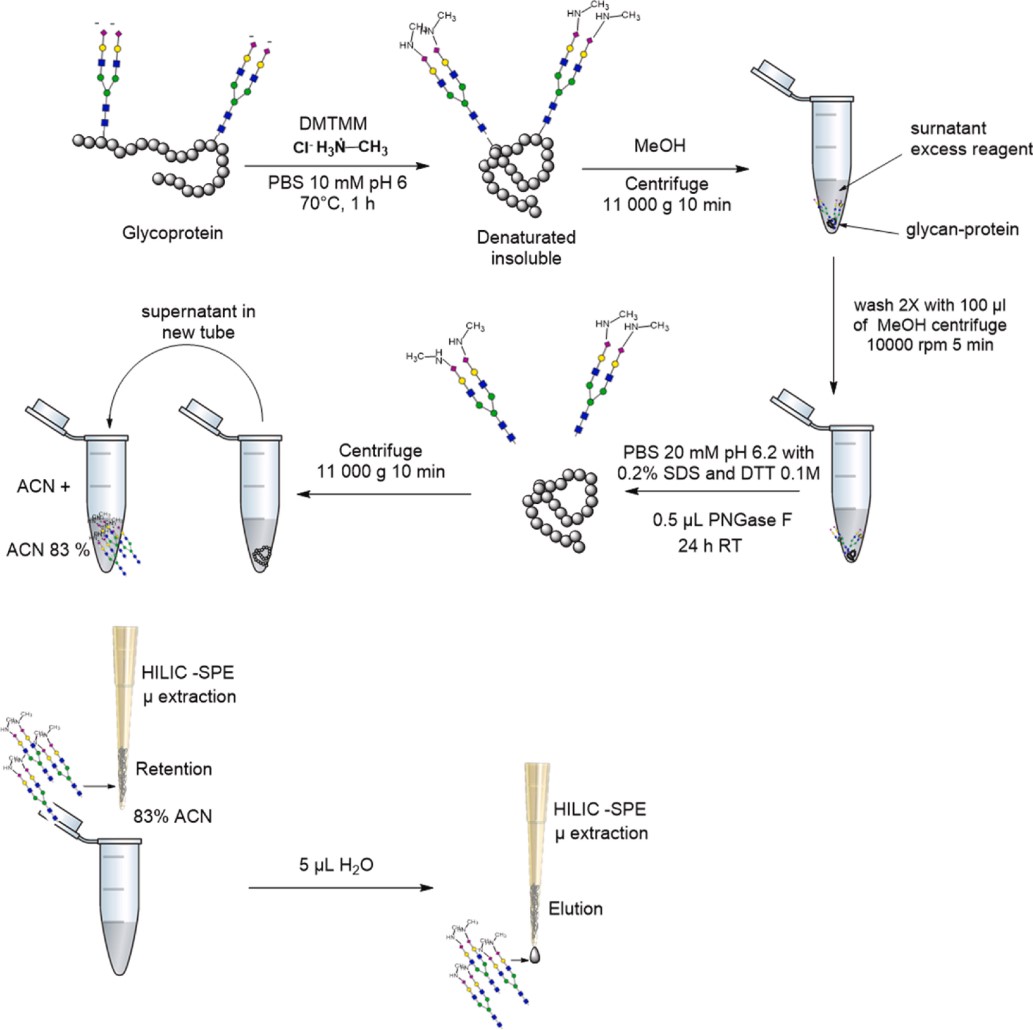Quantitative Sialic Acid Analysis Service
Quantitative Analysis of Sialic Acid at Creative Biolabs
As a component of oligosaccharide units in glycoproteins, glycolipids, and mucins, sialic acid is widely present in nature, among which N-acetylneuraminic acid and N-glycolylneuraminic acid are the two most important sialic acids. The content and structural changes of sialic acid in glycoproteins are related to various diseases, such as cancer, tumors, neurodegenerative diseases, etc. Creative Biolabs has an advanced analytical technology platform, we provide professional Glycoprotein Analysis and quantification, including sialic acid analysis, monosaccharide analysis, and glycosaminoglycan analysis services.
Our analytical experts have many years of rich experience in sialic acid analysis, and use a variety of technologies and methods to provide high-quality sialic acid quantitative analysis services.
Colorimetry
-
Pretreatment: We perform necessary pretreatment steps on glycoprotein samples to remove impurities or other interferences.
-
Spiking: We add an internal standard substance of known concentration to the sample as a reference substance.
-
Hydrolysis: We perform hydrolysis on glycoprotein samples, breaking them down into simple sugars and sialic acid.
-
Oxidation: We react the hydrolyzed sample with sodium iodate to oxidize sialic acid to dialdehyde under low pH conditions.
-
Reaction: We react the oxidized sample with resorcinol to form a purple complex.
-
Determination: Finally, we measure the absorbance or fluorescence intensity of the generated purple complex through the colorimetric method.
-
Calculate concentration: We use sialic acid standards of different concentrations to establish a standard curve and then calculate the concentration of sialic acid in the sample according to the results of the standard curve and the absorbance or fluorescence intensity of the sample.
Enzymatic method
We add sialyl hydrolase (such as sialidase) to the glycoprotein sample and optimize the reaction temperature, pH, and other conditions of the enzyme to release sialic acid in the glycoprotein. We then use chromatographic techniques or other analytical methods to separate the hydrolyzate and analyze it quantitatively or qualitatively. The enzymatic method is a method with high specificity and relatively simple operation, which is suitable for studying the content and structure of sialic acid in glycoproteins.
Chromatography-mass spectrometry
We extract and purify glycoprotein samples, achieve separation of sialic acid by optimizing chromatographic conditions, and perform mass spectrometry analysis. The chromatography-mass spectrometry method combines the separation power of high-performance liquid chromatography (HPLC) with the sensitivity and specificity of mass spectrometry, which is used to accurately determine the sialic acid content in glycoproteins and provide critical information for biomedical research.
Fluorescence method
We use a fluorescein labeling agent to react with sialic acid to generate a fluorescent product, and then use a fluorescence spectrometer or fluorescence plate reader to measure the fluorescence intensity in the sample to calculate the sialic acid content. The fluorescence method has high sensitivity, high selectivity, and a wide linear range, which is suitable for analyzing the sialic acid content in glycoproteins.

Published data
Glycans are essential biomolecules in biological systems, which are usually combined with proteins and lipids. Studies have found that specific types of glycans in serum serve as biomarkers for diseases. For example, the concentration and composition of sialic acid in cancer patients will change significantly. In this study, the authors used mouse intestinal lavage fluid and serum as the analysis objects. First, the samples were treated by methyl amidation to neutralize the charge of the sialic acid at the end of the N-glycans in the samples. Then, using protein as a solid support material, combined with matrix-assisted laser desorption/ionization mass spectrometry (MALDI-MS) technology, the N-glycans in the samples were analyzed in positive ion mode. The results showed that mono-sialic acid and di-sialylated N-glycan forms were detected in mouse serum, among which N-glycolylneuraminic acid (Neu5Gc) was the main one. Desialylated N-glycans were found in the intestinal lavage fluid of mice.
 Fig.1 Schematic diagram of sample preparation.1
Fig.1 Schematic diagram of sample preparation.1
Advantages
-
We have advanced detection equipment and professional analysis software, which can accurately and quickly analyze sialic acid.
-
We have standardized experimental procedures and quality control procedures to ensure the stability and repeatability of the sialic acid analysis process.
-
We provide fast and efficient analysis services, providing timely results to our clients. Moreover, we also provide personalized sialic acid analysis solutions.
Application
-
Disease monitoring: Changes in sialic acid levels are associated with a variety of diseases, such as liver disease, cancer, inherited metabolic disorders, etc. Sialic acid analysis helps diagnose and monitor disease progression.
-
Drug development: During drug development, sialic acid analysis is used to evaluate the impact of new drugs on metabolic pathways, verify drug efficacy, and understand drug interactions.
-
Food: Sialic acid analysis is used to detect the sialic acid content in food, helping to evaluate the freshness, quality, and authenticity of food and ensuring food safety.
Creative Biolabs has rich experience in glycoprotein analysis and professional teams, which enjoys a good reputation in the field of bioanalysis. We are committed to providing clients with high-level sialic acid analysis services. Please contact us if you are interested in our analysis service.
FAQ
Q1: What is the necessity of sialic acid analysis?
A1: Sialic acid plays a vital role in various biological processes, and its level is related to the development and progression of various diseases (such as cancer, liver disease, neurodegenerative diseases, etc.). By analyzing sialic acid, we help clients better understand disease mechanisms and provide a basis for early diagnosis and treatment.
Q2: What factors affect the measurement results of sialic acid?
A2: The interference of other components in the sample, sample storage conditions, pretreatment steps, and the choice of analysis method may affect the measurement results. The choice of analysis method depends on the sample type, the expected concentration of sialic acid, and the purpose of the study. Our experts provide clients with professional advice.
Q3: Can you analyze specific types of sialic acid?
A3: Yes, we analyze specific types of sialic acid, such as N-acetylneuraminic acid and N-glyceroneuraminic acid. According to the specific needs of clients, we provide quantitative analysis for target sialic acids. Our professional team will recommend the most appropriate analysis method according to the sample type and research purpose to help clients obtain the required research data and information.
Customer Review
Diversity of Analysis Techniques
“The variety of analysis techniques used by Creative Biolabs (such as colorimetry, enzymatic methods, and chromatography-mass spectrometry) makes the analysis process of sialic acid flexible and able to meet our different experimental needs.”
Highly Professional
“I am impressed by the professionalism of Creative Biolabs. From sample processing to the final results, the whole process reflects a high level of scientific research literacy. They not only provide quantitative analysis of sialic acid but also help us deeply understand the biological mechanism behind the data, which is of great help to our research.”
Reference
-
Ret, Davide, et al. "DMTMM-mediated methylamidation for MALDI mass spectrometry analysis of N-glycans with structurally conserved sialic acid residues in biological fluids “via direttissima”." Talanta 242 (2022): 123326. Distributed under Open Access license CC BY 4.0, without modification.
For Research Use Only.
Related Services


 Fig.1 Schematic diagram of sample preparation.1
Fig.1 Schematic diagram of sample preparation.1



